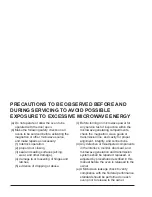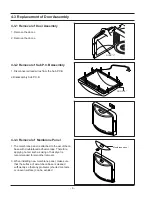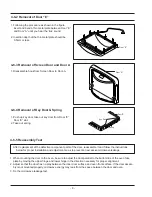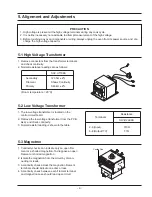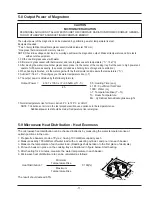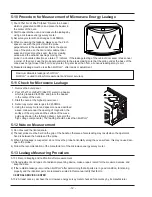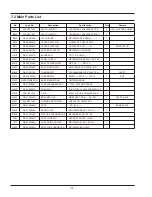
- 13 -
6. Troubleshooting
SYMPTOM
CAUSE
CORRECTIONS
Oven is dead.
Fuse is OK.
No display and no operation
at all .
1. Open or loose lead wire harness
2. Open thermal cutout (Magnetron)
3. Open low voltage transformer
4. Defective Ass’y PCB
Check fan motor when thermal
cutout is defective.
Check Ass’y PCB when L.V.T is
defective.
No display and no operation
at all. Fuse is blown.
1. Shorted lead wire harness
2. Defective Secondary latch switch
(NOTE 1)
3. Defective monitor switch (NOTE1)
4. Shorted H.V.Capacitor
5. Shorted H.V.Transformer (NOTE2)
Check adjustment of , Secondary
interlock monitor, power relay, door
sensing switch.
NOTE 1: All of these switches must be replaced at the same time.
(refer to adjustment instructions) Check continuity of power relay con-
tacts and if it has continuity, replace power relay also.
NOTE 2: When H.V.Transformer is replaced, check diode and magnetron also.
Oven does not accept
key input (Program)
1. Key input is not in-Sequence
2. Open or loose connection of membrane
key pad to Ass’y PCB
3. Shorted or open membrane panel
4. Defective Ass’y PCB
Refer to operation procedure.
Replace PCB main.
Timer starts countdown but
no microwave oscillation.
(No heat while oven lamp
and fan motor turn on.)
1. Off-alignment of latch switches
2. Open or loose connection of high
voltage circuit especially
magnetron fi lament circuit
NOTE: Large contact resistance will bring
lower magnetron fi lament voltage
and cause magnetron to lower out-
put and/or intermittent oscillation.
3. Defective high voltage components
H.V.Transformer H.V. Capacitor
H.V.Diode, Magnetron
4. Open or loose wiring of power relay
5. Defective Secondary latch switch
6. Defective power relay or Ass’y PCB
Adjust door and latch switches.
Check high voltage component ac-
cording to
component test procedure and
replace if it is
defective.
Replace PCB main.
PRECAUTION
1. CHECK GROUNDING BEFORE CHECKING FOR TROUBLE.
2. BE CAREFUL OF THE HIGH VOLTAGE CIRCUIT.
3. DISCHARGE THE HIGH VOLTAGE CAPACITOR.
4. WHEN CHECKING THE CONTINUITY OF THE SWITCHES OR TRANSFORMER, DISCONNECT ONE LEAD
WIRE FROM THESE PARTS AND THEN CHECK CONTINUITY WITHOUT THE POWER SOURCE ON. TO
DO OTHERWISE MAY RESULT IN A FALSE READING OR DAMAGE TO YOUR METER.
5. DO NOT TOUCH ANY PART OF THE CIRCUIT OR THE CONTROL CIRCUIT BOARD, SINCE STATIC DIS-
CHARGE MAY DAMAGE IT. ALWAYS TOUCH GROUND WHILE WORKING ON IT TO DISCHARGE ANY
STATIC CHARGE BUILT UP.
6-1 Electrical Malfunction


